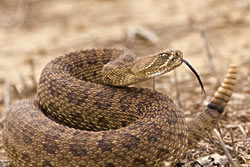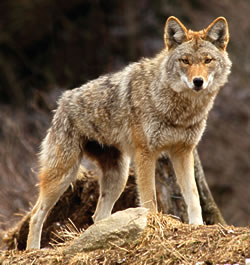FAMILY - FAMILY FEATURES
Drought Drives Wildlife Home from the Hills
Tips for Homeowners
August, 2007 - Issue #34
 |
Statistics tell us we can thank the lack of rain for this new invasion, not only by coyotes but also by deer, raccoons, skunks, rodents and snakes. With 2007 registering as the driest year on record for Los Angeles County - only 1.99 inches total rainfall in the SCV this year - the fauna of Southern California are leaving the hills for our well-watered lawns, fountains and swimming pools.
In May, Saugus resident Chris Bolewski had a close encounter with a Southern Pacific rattlesnake while clearing brush for a mountain-bike trail off Copperhill Road near Haskell Canyon. Bitten twice on the ankle, Chris initially experienced paralysis from the bite and was taken to Loma Linda University Hospital for treatment.
Chris learned how important it is to be aware of rattlesnakes, and advises everyone, regardless of whether they're at home or hiking in the desert, to be aware of their surroundings.
"Keep your eyes open," said Chris. "Be aware. Snakes are really camouflaged and hard to see."
Chris was lucky. He has almost completely recovered and expects to have no lasting effects from the bite.
With a little forward thinking, you can prevent your pets and loved ones from meeting a similar fate.
--------------------------------------------------------------
Protect Yourself
 |
Feed pets indoors or remove dishes immediately after feeding outdoors. Store pet-food bags indoors.
Clear brush, old boards, firewood, rocks, etc. from the yard, all of which are attractive hiding places for rodents and snakes. Use traps and rodenticides if necessary.
Make sure all access to the house is blocked. Cover vents with wire mesh. Make sure the foundation is free of cracks. Install weather stripping along bottom of garage doors.
Use tight-fitting lids on trash cans.
Put trash out on the morning of pickup, giving coyotes less time to scavenge, and without the cover of darkness. Coyotes are most active at night or twilight.
Build a tall fence around the yard to deter coyotes and other animals from climbing. For snake deterrence, the fence should extend several feet below ground, made of galvanized wire. Check the integrity of the fence from time to time. Make sure gates fit tightly and keep vegetation and debris away from fence.
Check for concealed snakes when gardening, moving brush, wood, logs or other debris. Watch where you step. Don't reach under bushes you can't see under.
Keep small pets indoors. Don't allow them to run free - ever. Cats, especially, are easy prey. Bring large dogs inside after dark.
If your dog is barking excessively or whining, check for a snake. Pets that have been bitten should be taken to the vet immediately.
Never leave small children unattended, even in your yard. Teach children respect for snakes and to leave them alone.
Never grab what looks like a stick or branch while swimming; rattlesnakes are excellent swimmers.
If you find a snake, call a professional specializing in snake removal. Do not try to move it yourself. Most snakebites occur when inexperienced people try to move them.
--------------------------------------------------------------
Accomplished Toxicologist Addresses Topic of Snake Bites at Henry Mayo
Dr. Jennifer C. Smith, an accomplished and published toxicologist specializing in envenomation (the process by which venom is injected into human beings through a bite of a venomous creature) at Loma Linda University Medical Center recently addressed physicians and staff at Henry Mayo Newhall Memorial Hospital on the subject of managing and treating rattlesnake bites.
This was a timely subject, because the Santa Clarita Valley is experiencing a three-year drought and with meteorologists forecasting hot weather ahead, it is likely that area residents will encounter more rattlesnakes this summer.
Dr. Smith explained that rattlesnakes are the only venomous snakes that exist in California. Out of six species of rattlesnakes found in the state, the Southern Pacific rattlesnake is the one to which the Santa Clarita Valley is home.
Dr. Smith noted that 10 percent to 25 percent of all rattlesnake bites occur without the snakes injecting venom into the body. She said symptoms of snake bites will typically occur within eight hours. If no symptoms occur after that time-period, the snake bite was most likely "dry," and no venom was injected.
There are about 7,000 reported snake bites in the United States each year. Of all the snake bites in the United States, only about 15 deaths per year are a result of a venomous snake bite. However, there are other related injuries such as limb loss and loss of feeling.
|
||||||||||||||||||||||||||||





